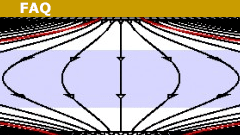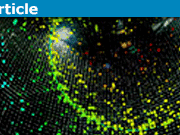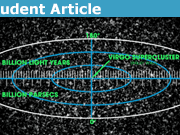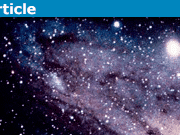What Is the Steady-state Model and Why It’s No Longer Viable
Table of Contents
Introduction to the Steady State Model
Back in 2011, I wrote a FAQ entry for Physics Forums on the steady state model and why it is no longer viable. Since then, I’ve learned more about the theory, and it turns out that Fred Hoyle was a lot cleverer than I’d assumed. The following is an update to that FAQ, providing a more technically accurate overview of the steady state model, albeit in a slightly abridged version compared to section 8.4 of my GR book.
Origins and Development of the Steady State Theory
From 1948 until around the mid-1960s, the Big Bang theory had viable competition in the form of the steady state model, originated by the British trio of Fred Hoyle, Hermann Bondi, and Thomas Gold. According to legend, they conceived the idea after watching a horror movie called *Dead of Night,* where events from the beginning of the story repeat later. This inspired them to imagine a universe that, while expanding, could remain locally in the same state at all times. For this to occur, the space between galaxies would have to be filled by the spontaneous creation of matter, assumed to be hydrogen atoms. The model appealed philosophically because it generalized the Copernican principle to apply not just to conditions everywhere in space but also at all times.
Philosophical Appeal and Publication History
The steady state idea was published in a pair of back-to-back papers—one by Bondi and Gold in 1948 and another by Hoyle the same year. The Bondi-Gold paper, in particular, is notable for its nontechnical language and for exemplifying a bold, creative approach to science that is rare today. The paper reads like a catalog of cherished principles of physics that were to be given up, including Lorentz invariance, general relativity, the equivalence principle, and possibly the laws of conservation of charge and mass-energy.
Core Principles of the Steady State Model
The core idea of the steady state model is that the universe is always in the same state, meaning that its rate of expansion, or the Hubble constant, must remain constant over time. This requires exponential growth, which implies that the geometry of the universe is that of de Sitter space. One major challenge for any model that assigns an infinite age to the universe is to explain why the universe has not undergone heat death due to the second law of thermodynamics. The steady state model addresses this problem by positing that the exponential expansion is rapid enough to prevent thermal equilibrium from ever being achieved.
Mathematical Foundation: Hoyle’s Contributions
Fred Hoyle sought to preserve the local conservation of energy-momentum, a requirement for the consistency of the Einstein field equations. Unlike Bondi and Gold, who advocated for replacing general relativity, Hoyle took a more conservative approach. He postulated the existence of a massless, chargeless scalar field, denoted as the “C field” (with “C” standing for “creation”). Hoyle’s model ensures that the C field contributes to the stress-energy tensor in a way that maintains local conservation of energy-momentum, resulting in a universe where the ordinary matter has positive energy density and pressure, while the C field contributes zero energy and negative pressure.
Conservation of Energy-Momentum and the C Field
To satisfy the requirement of local conservation of energy-momentum, the C field in Hoyle’s model must have specific properties. It must result in a zero divergence for the stress-energy tensor. A simple calculation using the Einstein field equations shows that this requires the C field to have a relationship akin to that of a cosmological constant, with ##\rho+P=0##. Hoyle constructed the model so that the C field has zero energy density and negative pressure, avoiding the incorrect assumption that the C field cancels out the positive energy of the matter being created.
Symmetry Considerations and Lorentz Invariance
Understanding why Hoyle’s theory took the form it did requires considering general physical principles about symmetry. As Bondi and Gold candidly admitted, any theory of this type would likely violate Lorentz invariance. For instance, when hydrogen atoms spontaneously appear in an evacuated box, their state of motion creates a preferred frame of reference. This breaks symmetry under Lorentz transformations, lacks time-reversal invariance (since matter appears but never disappears), and violates charge-conjugation symmetry (because matter appears but antimatter does not). These asymmetries are due to the model’s attempt to directly explain the observed asymmetries of the universe from the local laws of physics, a stark contrast to modern approaches that attribute such asymmetries to boundary conditions or spontaneous symmetry breaking.
Time Evolution and the Role of the Scalar Field C
Given that the C field is massless and chargeless, one would normally expect it to obey the wave equation ##\nabla_a\nabla^a C=0##. However, Hoyle’s C field does not evolve according to any Lorentz-invariant dynamical law. Instead, it evolves as ##C=t##, where ##t## is a preferred time coordinate. In Hoyle’s model, this time coordinate plays a crucial role in defining the C field, thus breaking Lorentz invariance. The value of the scalar field C itself does not have any directly observable effects because its time evolution would otherwise distinguish one epoch of the universe from another. Instead, the gradient ##\nabla_a C## forms a vector that defines a preferred frame of reference.
Preferred Frame of Reference and Observational Implications
In this preferred frame, an observer would be at rest relative to the local cosmological fluid, observe the universe as homogeneous, and notice that newly created atoms are, on average, at rest. This preferred frame is a key element in the steady state model and stands in contrast to the cosmological constant, which preserves the equivalence principle.
The C Field vs. the Cosmological Constant
The C field is akin to the cosmological constant in that it is a universally prescribed property of the vacuum. However, there is a significant difference: the cosmological constant’s contribution to the stress-energy tensor is proportional to the metric, preserving the equivalence principle. In contrast, the C field violates this principle. Bondi and Gold, based on personal communication from Hoyle, claimed that the C field exerts a force that produces a significant acceleration in an atom but a negligible one in a star.
Challenges to the Equivalence Principle
A key selling point of the C field was its supposed ability to prevent the formation of singularities, such as a Big Bang singularity and black holes. This is plausible because the C field violates the null and strong energy conditions, which are crucial for the Hawking-Penrose singularity theorems.
Singularities and the Steady State Model
The steady state model began to lose ground when Ryle and his collaborators counted radio sources and found that they did not match the statistical behavior predicted by the model. The final blow came with the discovery of the cosmic microwave background, which provided direct evidence that the universe had once been much hotter than it is now. Although there have been attempts to modify the model to account for these observations, none have been successful.
Conclusion and Further Reading
The steady state model, while a fascinating and philosophically appealing alternative to the Big Bang theory, ultimately succumbed to the weight of contrary evidence. For those interested in further details, a more comprehensive discussion can be found in Wright’s 2015 paper.
References
– Bondi and Gold, “The Steady-State Theory of the Expanding Universe,” MNRAS 108 (1948) 252;
http://adsabs.harvard.edu/cgi-bin/nph-bib_query?bibcode=1948MNRAS.108..252B
– Hoyle, “A New Model for the Expanding Universe,” MNRAS 108 (1948) 372;
http://adsabs.harvard.edu/cgi-bin/nph-bib_query?bibcode=1948MNRAS.108..372H
– Wright, “Errors in the Steady State and Quasi-SS Models,”
http://www.astro.ucla.edu/~wright/stdystat.htm
PhD in physics. I teach physics at Fullerton College, a community college in Southern California. I enjoy writing, playing viola, brewing beer, climbing and mountaineering.







